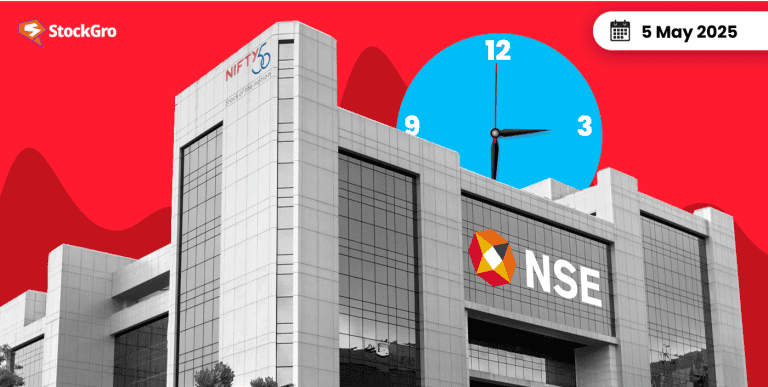
Tea and coffee are some of the most preferred beverages in India. Apart from high consumption, India is also a leading player in the export of these products. It is ranked 4th in the tea export and 7th in the total coffee production. Products like tea and coffee are mainly manufactured and exported by Karnataka, Kerala and Tamil Nadu.
This commercial edge makes the tea/coffee industry a potential investment avenue. The stock market can provide this opportunity. This blog explores the top 5 tea and coffee sector stocks in India.
Also, read Investment analysis: How to spot market underdogs worth betting on
Top 5 tea & coffee stocks in India
These are the top 5 tea and coffee stocks, categorised based on their market capitalisation as of April 16, 2025.
| Particulars | Market Capitalisation (in ₹ crores) | Price-to-Earning ratio (in times) | Return on Equity |
| Tata Consumer Products Ltd. | 1,09,428.65 | 83.42 | 8.32% |
| CCL Products India Ltd. | 8,338.15 | 30.47 | 15.77% |
| Vintage Coffee and Beverages Ltd. | 1,173.41 | 40.7 | 8.72% |
| Mcleod Russel India Ltd. | 396.41 | 0.00 | (261.11)% |
| Rossell India Ltd. | 311.90 | 11.37 | 27.43% |
Let’s dive deeper into the financial and fundamental dynamics of these stocks in detail.
It is one of the most popular tea brands in Indian households. Tata Tea stands as the 2nd largest tea brand in India. Moreover, Tetley is a leading brand in Canada.
Apart from this, brands like Tata Coffee and Grand have also performed potentially in recent years. Its financials are as follows:
| Particulars | FY 2024 | FY 2023 | Change (%) |
| Revenue (in ₹ crores) | 15,205.85 | 13,783.16 | 10.32 |
| Net Profit (in ₹ crores) | 1,215.40 | 1,320.14 | (7.93) |
| Operating Profit Margin | 14.2% | 13.6% | 4.41 |
| Debt-to-Equity (in times) | 0.13 | 0.03 | 333.33 |
The financials indicate moderate growth in recent years. Specifically, the revenue and operating profits have been improving for every financial year. The company’s stock price has declined by just 1.3% in a year as of April 16, 2025. However, the earnings per share (EPS) has been fluctuating.
The company has a wide range of coffee products under its brand ‘Continental Coffee’. Its products are available in retail outlets like D-mart, Reliance Fresh, etc. Its financials are as follows:
| Particulars | FY 2024 | FY 2023 | Change (%) |
| Revenue (in ₹ crores) | 2,653.70 | 2,071.21 | 28.12 |
| Net Profit (in ₹ crores) | 250.07 | 283.96 | (11.93) |
| Operating Profit Margin | 17.01% | 19.46% | (12.58) |
| Debt-to-Equity (in times) | 0.40 | 0.33 | 21.21 |
Investing in coffee stocks can provide the desired diversification to the portfolio. However, analysing their financials and operations is crucial. The CCL Product’s financials have dipped in FY 2024. However, quarterly results indicate a recovery in FY 2025. Also, its share price has surged by 9.7% in a year’s timeframe as of April 16, 2025.
- Vintage Coffee and Beverages Ltd.
Incorporated in 1980, the company has been a key player in coffee production and packaging in India. It earns major revenue from South Asia, Middle East and Africa regions as of Q3 FY 2025. Its financials are as follows:
| Particulars | FY 2024 | FY 2023 | Change (%) |
| Revenue (in ₹ crores) | 131.03 | 62.89 | 108.34 |
| Net Profit (in ₹ crores) | 11.98 | 3.86 | 208.03 |
| Operating Profit Margin | 19.83% | 25.08% | (20.93) |
| Debt-to-Equity (in times) | 0.58 | 0.94 | (38.29) |
The decline in debt to equity ratio may be due to decreasing debt or increase in equity, which can be a positive sign for investors. The share price of Vintage Coffee has surged 78.27% in a year as of April 16, 2025.
- Mcleod Russel India Ltd.
The company is claimed to be the largest tea-producing entity in the world. Established in 1869, it owns tea estates in West Bengal and Assam. It exports to countries like the United Kingdom, Dubai and Kenya. Its financials are as follows:
| Particulars | FY 2024 | FY 2023 | Change (%) |
| Revenue (in ₹ crores) | 1,135.88 | 1,369.57 | (17.06) |
| Net Profit (in ₹ crores) | (311.59) | (1,056.51) | 29.49 |
| Operating Profit Margin | (8.31) | (60.09) | 86.18 |
| Debt-to-Equity (in times) | 12.24 | 4.37 | 180.09 |
It is one of the tea stocks that has gained significantly in a year despite global trade pressure. It has surged by 40.3% in a year as of April 16, 2025.
- Rossell India Ltd.
The ‘Rossell Tea’ division of this company accounts for nearly 41% of the revenue in FY 2024. Established in 1994, the company exports to countries like Egypt, Netherlands, Germany, etc. Its financials are as follows:
| Particulars | FY 2024 | FY 2023 | Change (%) |
| Revenue (in ₹ crores) | 366.65 | 353.59 | 3.69 |
| Net Profit (in ₹ crores) | 12.72 | 27.64 | (53.97) |
| Operating Profit Margin | 12.27% | 16.20% | (24.25) |
| Debt-to-Equity (in times) | 0.65 | 0.56 | 16.07 |
The share price of this entity has declined nearly 26.7% in a year’s timeframe as of April 16, 2025. Moreover, its EPS has also been in a declining trend.
Dive deeper! Introduction to Fundamental Analysis
Bottomline
Tea and coffee are key commodities in terms of consumption and export. Investing in tea and coffee sector stocks may provide a unique diversification for the portfolio. However, one investment pattern may not suit every investor. Therefore, investors should analyse their investment goals and risk tolerance. It can simplify the investment decision.
Explore more: What Makes a Stock the Best for Long-Term Investments?
FAQs
- Which is the best coffee stock in India
Based on the market capitalisation, CCL Products India Ltd. is one of the best coffee stocks. Its revenues have been on the uptrend for the past few years, and its global presence reflects its fundamental strength. Moreover, its stock has managed to gain 9.34% in a year as of April 16, 2025.
- Are tea stocks a good investment?
The Indian tea industry has always been a significant contributor to the export prowess of India. It is the 4th largest exporter in the world. However, weather conditions can significantly affect the industry. Therefore, investors should analyse a particular investment opportunity and market conditions before investing.
- What is the difference between operating and net profit?
The operating profit and net profit differ based on the type of expenses deducted from the total revenue. When the expenses regarding manufacturing and operations are deducted from the total income, the surplus is the operating profit. However, when expenses like interest, depreciation, and taxes are removed from the operating profit, net or clear profit is derived.
- Is the stock market safe for beginners?
The direct exposure to market volatility makes the stock market a risky avenue. However, its risk level may differ based on the specific stocks and the industry. Therefore, beginners can identify low-risk opportunities to enter the market and monitor to avoid extreme market conditions. Moreover, one should also determine risk tolerance before investing in the stock market.
- How to interpret the P/E ratio?
The price-to-earnings ratio or P/E ratio is a valuation matric. It evaluates how much an investor is paying to earn the part of profit (EPS). There is no ideal P/E ratio it may differ based on the industry or product. However, a ratio lower than the industry median or average is considered an undervalued opportunity.

